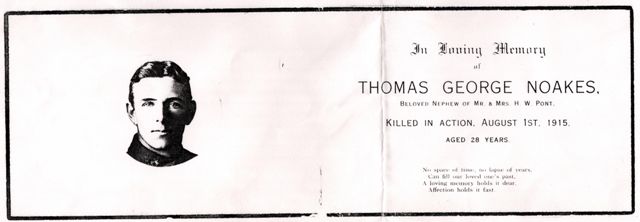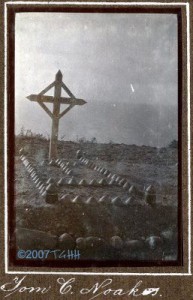Category: Military
Rank: Private 578
Regiment or Ship: 11th Battalion Australian Infantry
Service Number(s): 578
Occupation: Prospector
Date of Birth: 22.03.1887
Place of Birth: Mayfield, Sussex
Date of Death: 01.08.1915
Place of Death: Gallipoli
Place of Burial / Memorials:
Shell Green Cemetery Plot II; Row G; Grave 42.
Address: Glebe Cottage, Hooe
Photos and newspaper articles
Family Information
Parents:
Frank Noakes, born on 24th June 1860, at Milkhurst Toll, Heathfield and Caroline Pankhurst born on 24th January 1862, at Fair Oak Street, Mayfield. In 1882 on 4th November the couple were married at St Philip’s Church, Burwash Weald, Mayfield.
Siblings:
Henry Charles Noakes (known as Harry) – born 1883, in Burwash, Sussex, died in Hooe, Sussex, in 1892, aged 9 years.
William John Noakes born 11th August 1884 in Burwash, Sussex. Died 11th March 1951, in Fairlight Sussex. Joined the Royal Navy in 1904 for 12 years – Service records survived.
Levi Matthew Noakes – born 1889, in Mayfield, Sussex (recorded as ‘Matthew’ in the 1901 census and sometimes known as “Matthew Levi”).
Frank Noakes – born 1892, in Mayfield, Sussex. In late 1912, Frank married a Mary Ann King and they had three children, a son Frank in 1912, and daughters Ellen May in 1914, and Lily in 1917. Frank’s wife Mary Ann died in 1975 and Frank died seven years later in 1982. They are both buried in Bodle Street Green, Hailsham. Their headstone carries the following information – “Mary Ann Noakes, 24th October1975 aged 82, and Frank Noakes, 13th January 1982, aged 90”.
Walter Noakes – born 16th October 1893 in Peppering Eye Farm, Battle, Sussex. Died 23rd July 1969, in Perth, Western Australia.
Lilian May Noakes – born in 1896, in Hooe, but died in late 1897. She is buried with her parents in the Churchyard of St Oswald in Hooe.
Note: Mercy appears to have been Caroline’s illegitimate daughter.
In Australia, Thomas enlisted in the Australian Infantry, and, shortly afterward, married an Adéle Dinah Louise Westcott, in Fremantle. From his many Australian Service Records it is clear that he and Adéle didn’t have any children.
First World War Experience
On the 2nd November 1914, the 11th Battalion embarked, on “H.M.A.T” Ascanius” (His Majesty’s Australian Transport Ship) bound for Alexandria in Egypt to train with British weapons.
A few months later, on the 2nd March, 1915, Thomas embarked, on H.M.S. “Suffolk” from Alexandria bound for the Gallipoli Peninsular but according to his “War Gratuity Schedule”, on 8th April 1915, Thomas was admitted to No. 1, Stationary Hospital, Lemnos, Greece, with measles. Six days later on 14th April, he was declared well and discharged to rejoin his unit which he officially did on 22nd April.
The Gallipoli peninsula was basically barren and very rocky with steep hills, many gullies and narrow ledges. The beaches, on which the landings were to take place, were sandy. The Allied plan was to land troops at several points along the coast, establish a beachhead, and move inland. Thomas Noakes joined his unit on the 22nd April and on the 25th April the landings began.
The combined Australian and New Zealand Army Corps, the “Anzacs”, were landed at what later became known as “Anzac Cove”, which is a small and narrow stretch of beach with steeply rising barren land open to snipers higher up, with no cover except for the many gullies which scored its surface which the men would have to climb to get off that beach – and about a mile north of where they were supposed to have been landed. It′s thought that the wrong place was due to a navigational error – whatever the reason it was pretty disastrous for the Anzacs.
The first off the landing crafts and on the beach were the Australians and among them was Thomas Noakes. The beach offering very little cover, soon became crowded. Later that morning, the New Zealanders followed and joined the Aussies who, by this time, had managed to struggle through the rough terrain just about one and a quarter miles under the constant fire from the Turkish troops higher up and hidden in the gullies.
The Turks pushed back that initial ANZAC move inland, and the situation became so bad, so bloody and costly in men′s lives, that it was considered taking the troops off again but this, because of what else was going on along the coast, was considered to be impracticable and would have placed the troops in greater danger as they tried to leave, so the Anzacs dug in and waited until eventually they could be moved. Attacks all along the coast continued over the next few months with no real advance being made by the Allied forces and the Anzacs, including Thomas, were moved from battle to battle.
Thomas was most likely killed during the Battle of Leane’s Trench which began on 29th July at Gallipoli. Because of Turkish attempts to extend their trenches, which threatened the position of the Australians, a decision was made to carry out an attack to capture those trenches. The attack was, however, postponed for two days to allow for tunnels to be dug right up to the Turkish trenches where bombs would be placed and detonated as part of the attack, which was now planned for moonrise on the night of July 31st, and the 11th Battalion (with Thomas Noakes) would deliver that attack.
By the morning of the 1st August 1915 the position had been captured and the trench became known as “Leane’s Trench” after the officer (Brigadier General Sir Raymond Leane) who led the successful attack – but it had been won at a price. The 11th Battalion had 73 wounded and lost 36 men killed in action, one of which was almost certainly Thomas George Noakes.
Additional Information
In time Thomas’s wife received his medals, a photograph of the grave, and his memorial plaque and scroll but she doesn’t seem to have married again, at least not within the next four years, after which there seems to be no trace of her.
Background Information on Thomas’s Parents:
Caroline Noakes died in 1898, and on Sunday morning the 19th June 1904 Frank was found drowned in a ditch in the marshes near Hooe. No reason could be found as to why he would be in the ditch but he was employed by Mr. J. E. Brand of Hooe as a cowman and it seems that he was crossing the ditch on a narrow bridge and fell from there into the water. He was known to suffer from fainting fits.
With the loss of both parents the children were looked after by their grandparents, Matthew and Sarah Pont (née Noakes).
In 1891 the children’s uncle and aunt, Henry (known as Harry) and Alice Pont had emigrated to South Australia moving on to the Bardoc area in the goldfields of the Kalgoorlie region, in Western Australia in 1896.
Thomas had already emigrated to Western Australia before his father had died – he arrived in Fremantle aboard the ship “Orizaba” from London on 26th November 1903 as a 16 year old. He went to stay with his uncle and aunt, Harry and Alice Pont, in what was now the new gold rush town of Bardoc, where he became a prospector.
Harry and Alice also offered to pay the passage to Australia for the remaining brothers – Frank wanted to emigrate to Australia, but his wife Mary refused to go.
Walter accepted the offer and emigrated to Western Australia arriving in Fremantle 3 July 1913 aboard the “Belgic” from Liverpool. He moved about the wheat-belt, in Southern Australia, before the Great War and then enlisted in the Australian Imperial Force (AIF) on 2nd July 1915 (service number 3098). Walter came back to England for a short while where he met and married a Gladys Victoria Martin in St. Olave London. On 16th January 1918 he returned to Australia with his wife aboard the “Konigin Luise” arriving Fremantle 10th August 1919 (his brother Levi and his wife travelled on the same ship). In 1957, he visited England to collect an OBE for services to agriculture.
Levi Matthew also accepted the offer, and arrived in Fremantle, Western Australia, on 8th November 1913 aboard the “Lealandie” from Liverpool. Levi’s movements are not known but it is presumed that he “knocked about” the wheat-belt and the goldfields before the Great War. He enlisted in the Australian Imperial Force”, service number 3099, on 3rd July 1915, a day after his brother Walter.
Levi came to England after the war (probably with brother Walter, but, if so, the reason is not known) where he met and married Annie (known as Nell) Brett, in the winter of 1919. He returned to Australia, with his wife, aboard the “Konigin Luise” arriving in Fremantle on 10th August 1919.
Levi and Nell Noakes lived at Allanson, near the town of Collie, in Western Australia (about a 120 miles south of Perth). Both are buried in the Collie cemetery. Nell was awarded an OBE (Military Division) for services during the First World War. Nell’s parents are buried in St Oswald’s churchyard, Hooe.
Levi was awarded an OBE for services to agriculture in 1957 and he travelled to England to receive his award.
During the First World War, Walter and Levi were both awarded the Military Medal and bar for gallantry in 1916. The commendation says, “Near MOUQUET FARM. For gallantry and devotion to duty as stretcher bearers. On the night of 14/15th Aug. 1916, these brothers repeatedly bandaged and carried in wounded men under heavy shell and machine gun fire from “No Man’s Land”. On the 15th August through heavy shell fire they brought a serious case down to the battalion Aid Post. Though much exhausted they volunteered again to go out in response to an urgent call to battalion Headquarters passing through a heavy barrage and bandaging and helping wounded until completely breaking down from fatigue.”



